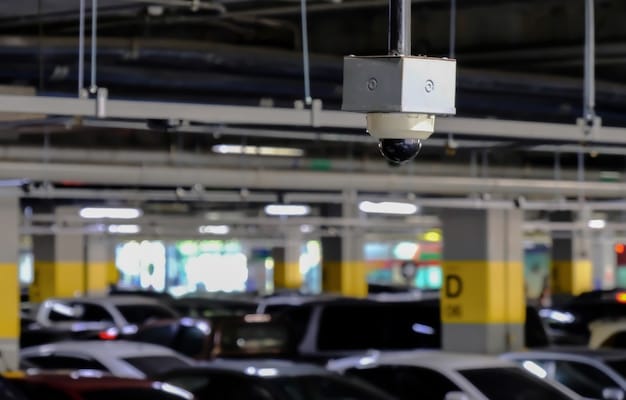CPTED: Enhancing Community Safety Through Environmental Design

Crime Prevention Through Environmental Design (CPTED) is a multi-disciplinary approach that utilizes urban and architectural design to reduce crime and improve the quality of life in communities by addressing environmental factors that influence criminal behavior.
Crime Prevention Through Environmental Design (CPTED): Creating Safer Communities is a proactive approach to crime reduction. It focuses on how the built environment can be designed and managed to deter criminal behavior and enhance the safety and quality of life for residents.
Understanding Crime Prevention Through Environmental Design (CPTED)
Crime Prevention Through Environmental Design (CPTED) offers a unique approach to enhancing community safety. It focuses on the strategic design and management of the built environment to reduce crime and promote a sense of security among residents. By understanding the core principles of CPTED, communities can create spaces that deter criminal activity and foster positive social interactions.
Core Principles of CPTED
CPTED is based on several core principles that guide the design and management of spaces to reduce crime. These principles are not standalone solutions but are often implemented in combination to achieve the best results.
- Natural Surveillance: Designing environments to maximize visibility, making it easier for people to observe activities and deter potential offenders.
- Natural Access Control: Limiting access to specific areas through physical barriers and strategic placement of entrances and exits.
- Territorial Reinforcement: Creating a sense of ownership and community pride, making residents more likely to monitor and protect their space.
These principles, when applied thoughtfully, can transform public and private spaces into safer and more vibrant areas.
CPTED’s success lies in its holistic approach, combining design, management, and community engagement to create safer environments. By understanding and implementing these principles, communities can proactively address crime and improve the quality of life for all residents.

The Five Strategies of CPTED
CPTED is implemented through five key strategies that work together to prevent crime and enhance community safety. These strategies are designed to address different aspects of environmental design, ensuring a comprehensive approach to crime prevention. By understanding these strategies, communities can tailor CPTED implementations to their specific needs and challenges.
Surveillance
Surveillance involves making it easier to see what’s happening in a space. This can be achieved through various design elements that increase visibility and reduce opportunities for offenders to act unnoticed.
- Improving lighting to eliminate dark spots and enhance visibility at night.
- Positioning windows and doors to provide clear lines of sight.
- Using landscaping to maintain open views and prevent hiding places.
Access Control
Access control focuses on limiting entry to specific areas, making it more difficult for unauthorized individuals to gain access. This can be achieved through physical barriers, strategic placement of entrances and exits, and clear signage.
- Installing fences, gates, and other barriers to restrict access to private or sensitive areas.
- Using security cameras and alarm systems to monitor access points.
- Implementing key card or biometric entry systems for controlled access.
Territoriality
Territoriality involves creating a sense of ownership and community pride, encouraging residents to take responsibility for their space. This can be achieved through design elements that define boundaries and create a sense of belonging.
- Using landscaping, signage, and decorative features to define property lines and boundaries.
- Creating communal spaces that encourage social interaction and community building.
- Encouraging residents to personalize their homes and yards to foster a sense of ownership.
Additionally, effective territorial reinforcement strengthens community bonds and fosters a sense of collective responsibility for safety.
Maintenance
Maintenance involves keeping spaces clean and well-maintained, signaling that the area is cared for and monitored. Neglected properties can attract crime, while well-maintained environments deter offenders.
- Regularly cleaning and repairing buildings, landscaping, and infrastructure.
- Promptly addressing graffiti, vandalism, and other signs of neglect.
- Implementing community cleanup programs to foster a sense of pride and responsibility.
Consistent maintenance is a visible sign of community investment, deterring crime and enhancing the quality of life.
Activity Support
Activity support refers to strategies that encourage and support positive use of public spaces, making them more vibrant and less attractive to criminal activity.
- Organizing community events and activities in public spaces.
- Providing amenities such as benches, tables, and playgrounds to encourage social interaction.
- Supporting local businesses and community organizations that contribute to the vibrancy of the area.
Activity support fosters a sense of community and purpose, making public spaces safer and more enjoyable for everyone.

Implementing CPTED in Urban Planning
CPTED principles can be effectively integrated into urban planning to create safer, more vibrant communities. By considering CPTED strategies early in the planning process, developers and city officials can design environments that naturally deter crime and enhance the quality of life for residents.
Integrating CPTED into New Developments
When planning new developments, consider incorporating CPTED principles from the outset. This can involve designing streets and buildings to maximize visibility, controlling access to sensitive areas, and creating communal spaces that encourage social interaction.
Enhancing Existing Neighborhoods with CPTED
CPTED can also be implemented in existing neighborhoods through targeted improvements. This can involve upgrading lighting, improving landscaping, and installing security measures in areas prone to crime.
- Conducting a CPTED audit to identify areas in need of improvement.
- Working with residents to prioritize projects and gather feedback.
- Partnering with local organizations and businesses to implement changes.
By retrofitting CPTED principles into existing neighborhoods, communities can address long-standing crime issues and create safer environments for all residents.
Implementing CPTED effectively often requires collaboration between various stakeholders, including residents, developers, city officials, and law enforcement. By working together, these groups can create environments that are both safe and welcoming.
Benefits of CPTED
CPTED offers numerous benefits beyond crime prevention. By creating safer, more attractive environments, CPTED can improve the quality of life, foster community pride, and boost economic development.
Improved Safety and Security
The primary benefit of CPTED is improved safety and security. By deterring crime and enhancing surveillance, CPTED can reduce opportunities for criminal activity and create a sense of security among residents.
Enhanced Quality of Life
CPTED can also improve the quality of life by creating more attractive and welcoming environments. Well-lit streets, clean parks, and pedestrian-friendly designs can make neighborhoods more enjoyable for everyone.
Stronger Community Connections
CPTED strategies that encourage social interaction and community building can strengthen community connections. Communal spaces, community events, and neighborhood watch programs can foster a sense of belonging and collective responsibility.
Economic Benefits
Safe and attractive neighborhoods are more likely to attract investment and economic development. CPTED can boost property values, attract businesses, and create jobs, contributing to the overall prosperity of the community.
The benefits of CPTED extend far beyond crime prevention, enhancing the overall livability and prosperity of communities.
Challenges and Considerations in CPTED Implementation
While CPTED offers numerous benefits, there are also challenges and considerations that must be addressed to ensure successful implementation. These include cost, community involvement, and the potential for unintended consequences.
Cost
Implementing CPTED can be costly, especially when making significant changes to the built environment. However, the long-term benefits of crime reduction and improved quality of life often outweigh the initial investment.
To minimize costs, communities can prioritize low-cost, high-impact strategies such as improving lighting, clearing vegetation, and organizing community cleanup programs. Additionally, seeking grant funding and partnering with local organizations can help offset expenses.
Community Involvement
Successful CPTED implementation requires strong community involvement. Residents must be actively engaged in the planning process to ensure that their needs and concerns are addressed. This can involve conducting surveys, holding community meetings, and establishing advisory committees.
Potential for Unintended Consequences
CPTED strategies can sometimes have unintended consequences, such as displacing crime to other areas or creating barriers that limit access for certain populations. To mitigate these risks, it is important to carefully consider the potential impacts of each strategy and to monitor the results over time.
Addressing these challenges and considerations is essential for ensuring that CPTED is implemented effectively and equitably.
CPTED in Action: Real-World Examples
CPTED has been successfully implemented in numerous communities around the world, demonstrating its effectiveness in reducing crime and improving quality of life. Here are a few real-world examples of CPTED in action.
Example 1: Enhancing Park Safety
A city park was experiencing high rates of crime and attracting few visitors. To address this issue, the city implemented CPTED strategies such as improving lighting, clearing vegetation, and installing security cameras. As a result, crime rates in the park decreased significantly, and more people began using the space for recreation.
Example 2: Revitalizing a Downtown Area
A downtown area was struggling with high vacancy rates and a perception of unsafety. To revitalize the area, the city implemented CPTED strategies such as improving streetscapes, encouraging mixed-use development, and organizing community events. These efforts attracted new businesses and residents, leading to a significant improvement in the area’s economic vitality and safety.
Example 3: Improving School Safety
A school was experiencing issues with vandalism and trespassing. To address these concerns, school officials implemented CPTED strategies such as installing security fencing, improving lighting, and creating a welcoming entrance area. These changes enhanced the school’s security and created a more positive learning environment.
These examples demonstrate the versatility of CPTED and its potential to transform communities.
| Key Point | Brief Description |
|---|---|
| 💡 Natural Surveillance | Maximize visibility to deter offenders. |
| 🔒 Access Control | Limit entry with barriers and systems. |
| 🏡 Territoriality | Create ownership for community pride. |
| 🌱 Maintenance | Keep spaces well-maintained to deter crime. |
Frequently Asked Questions (FAQs)
▼
The primary goal is to reduce crime and improve the quality of life by designing environments that deter criminal behavior and promote a sense of safety.
▼
Natural surveillance involves designing spaces to maximize visibility, making it easier for people to observe activities and deter potential offenders.
▼
Examples include installing fences, using security cameras, and implementing key card entry systems to limit access to specific areas.
▼
Maintenance signals that an area is cared for, deterring crime by showing that the space is monitored and valued by the community.
▼
Communities can participate by attending meetings, conducting surveys, and joining committees to provide input on CPTED projects and initiatives.
Conclusion
Crime Prevention Through Environmental Design (CPTED): Creating Safer Communities offers a powerful framework for preventing crime and enhancing the quality of life in communities. By understanding and implementing CPTED principles, communities can create safer, more attractive environments that foster a sense of belonging and collective responsibility.





